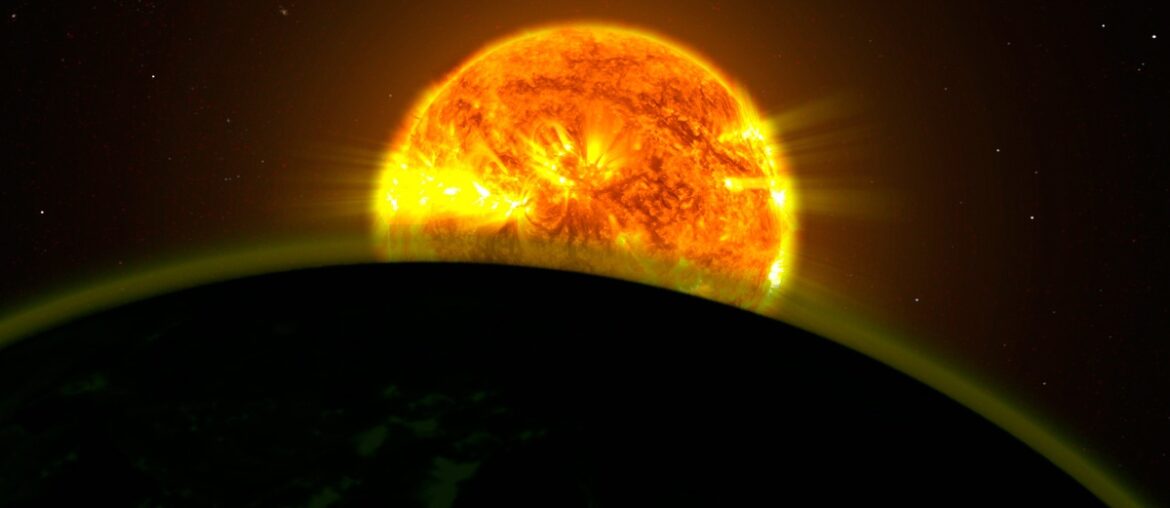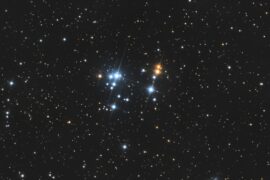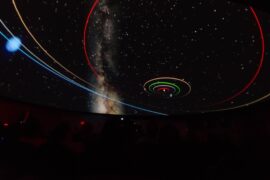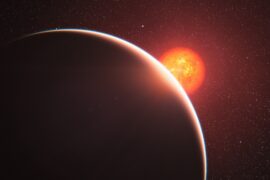8 Types of Exoplanet Atmospheres
In 2001 astronomers measured sodium in the atmosphere of HD 209458 b — the first time we probed an alien sky. Since then, telescopes have confirmed more than 5,500 exoplanets as of 2024 and the James Webb Space Telescope (launched in 2021) has begun returning rich spectra that reveal chemical fingerprints, clouds, and thermal structure.
Studying different types of exoplanet atmospheres tells us how planets form, evolve, and whether they might host life. This guide describes eight atmosphere classes—from primordial hydrogen envelopes to hazy, evaporating worlds—what each reveals about origin and habitability, and which planets illustrate the physics and chemistry at play.
Primordial, Hydrogen–Helium Atmospheres
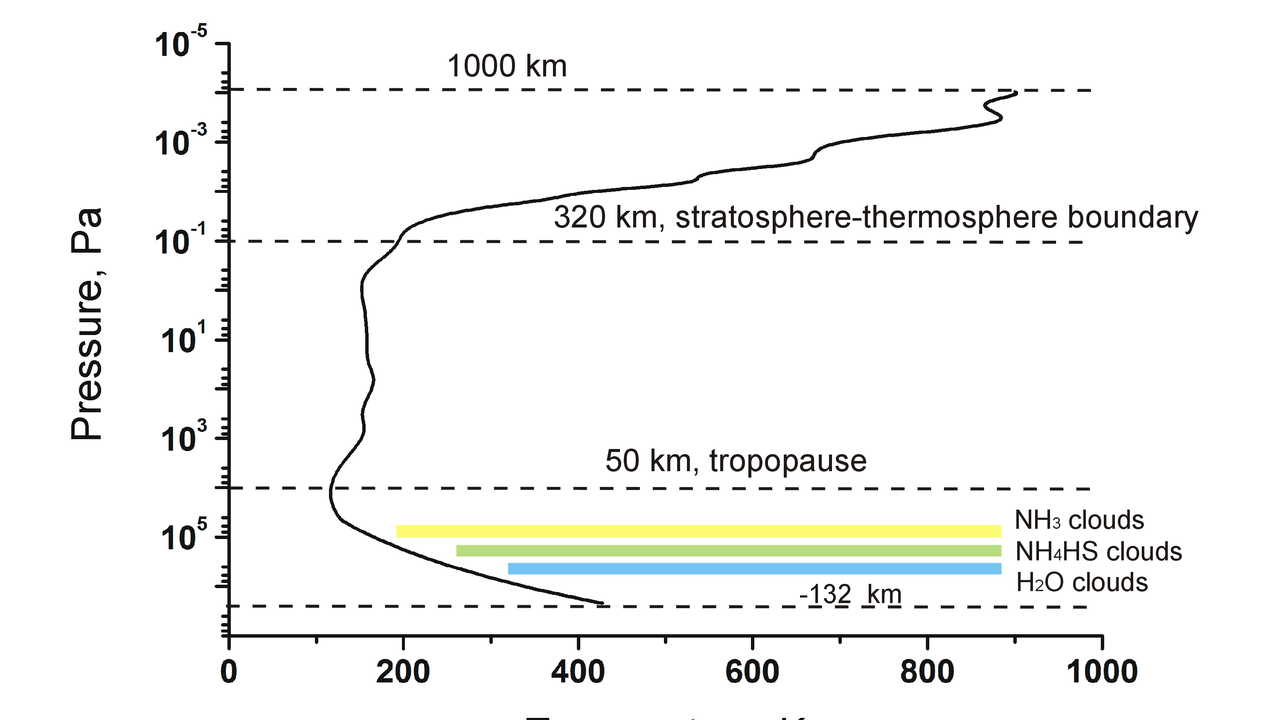
Primordial atmospheres are envelopes a planet captures from the protoplanetary disk and are dominated by hydrogen and helium. Massive cores (and planets with low escape velocities) hold onto these light gases, producing large radii and extended scale heights—sometimes hundreds of kilometers for hot gas giants—so transmission spectra show strong molecular and atomic lines. These H/He envelopes are central to formation and migration models and help explain the observed radius gap between rocky planets and mini-Neptunes.
1. Hydrogen–helium (primordial) atmospheres
H/He primordial atmospheres are the archetype for gas giants and many sub-Neptunes: massive envelopes left from the disk that dwarf any rock or ice core. The first detection of an exoplanet atmosphere—sodium in HD 209458 b in 2001—relied on the large scale height of such a hot Jupiter, which makes spectral lines prominent. Observationally, these worlds show deep molecular bands (H2O, CH4, CO) and broad atomic lines, allowing composition and temperature profiles to be constrained. Knowing which planets retain primordial gas informs core-accretion timelines, migration histories, and why some small planets remain “fluffy” while similar-mass neighbors are rocky (the radius valley problem). Examples: HD 209458 b and the low-density WASP-107 b.
2. Inflated and ultra-hot gas atmospheres
Close-in gas giants can be inflated by stellar heating; at extreme irradiation, dayside temperatures exceed 2,500–4,000 K and molecules dissociate into atoms. KELT-9b, with dayside temperatures above 4,000 K, shows signatures of atomic metals, while WASP-76b exhibits high-temperature chemistry and tentative evidence for iron condensation on the nightside. These atmospheres can develop thermal inversions and strong atomic emission or absorption lines (e.g., Fe, Mg). They test high-temperature chemistry and material behavior in regimes akin to laboratory plasmas and offer direct probes of atmospheric dynamics via phase-resolved thermal emission.
3. Mini-Neptune / sub-Neptune hydrogen-rich envelopes
Planets with radii roughly 1.5–4 Earth radii often retain modest H/He envelopes over rocky cores; these are called sub-Neptunes or mini-Neptunes. The atmospheric mass fraction controls whether a planet appears “fluffy” or compact, contributing to the observed radius valley. Spectra from these worlds can be muted by high mean molecular weight atmospheres or obscuring clouds, so retrievals sometimes return ambiguous metallicities. Notable examples include GJ 1214 b (a cloudy or metal-rich sub-Neptune with a flat transmission spectrum) and GJ 3470 b, which is a low-density, hydrogen-bearing world that helps anchor small-planet demographics.
Secondary and Terrestrial-like Atmospheres

Secondary atmospheres are produced after the primordial gas is lost—via outgassing, volcanism, impacts, or biological processes—and tend to have higher mean molecular weights. Small, rocky planets commonly rebuild atmospheres rich in heavier molecules (CO2, N2, H2O), and their compositions are shaped by interior chemistry and stellar environment. These atmospheres are the primary focus for habitability and biosignature searches because they set surface conditions; detecting an Earth-like mix (N2–O2) or a steam- or CO2-dominated envelope would tell entirely different origin stories. Below are three terrestrial-like classes that illustrate this diversity.
4. Nitrogen–oxygen (Earth-like) candidate atmospheres
An N2–O2 dominated atmosphere would imply temperate surface pressure, long-term climate stability, and, potentially, biological activity if oxygen is abundant. Temperate rocky planets around M dwarfs—TRAPPIST-1e among them—are high-priority targets for searching for Earth-like gases with JWST and future missions. Detecting O2 or N2 directly is difficult: N2 is spectrally inert in most bands and O2 features are weak, so observers rely on indirect techniques (e.g., collision-induced absorption or associated biosignature gas combinations). Still, a confirmed N2–O2 atmosphere on a temperate world would be a watershed discovery for habitability studies.
5. Carbon dioxide–dominated (Venus-like) atmospheres
CO2-rich envelopes create powerful greenhouse warming and can trap a planet in a runaway greenhouse state—Venus is the archetype, with a surface pressure near 92 bar. Many close-in rocky exoplanets could evolve into CO2-dominated worlds after losing lighter gases, producing high surface temperatures and thick clouds that raise albedo. Spectrally, CO2 produces strong infrared bands that are relatively straightforward to detect, which helps distinguish a Venus-like climate from an Earth-like one. Candidates that might host dense CO2 atmospheres include compact, highly irradiated planets such as GJ 1132 b (though its true state remains under study).
6. Water-rich and steam atmospheres
Water-rich atmospheres range from vapor-dominated steam envelopes (for runaway-greenhouse planets) to more moderate, water-bearing atmospheres with clouds. Observationally, water vapor produces strong infrared absorption bands; Hubble reported water vapor features for K2-18b in 2019, and JWST follow-ups since 2021 are refining those detections and constraining cloud properties. Close-in rocky worlds that receive intense stellar flux may boil off oceans and develop steam atmospheres, while temperate sub-Neptunes with abundant volatiles could retain thick, water-rich envelopes—both scenarios are crucial for assessing habitability.
Exotic, Escaping, and Hazy Atmospheres
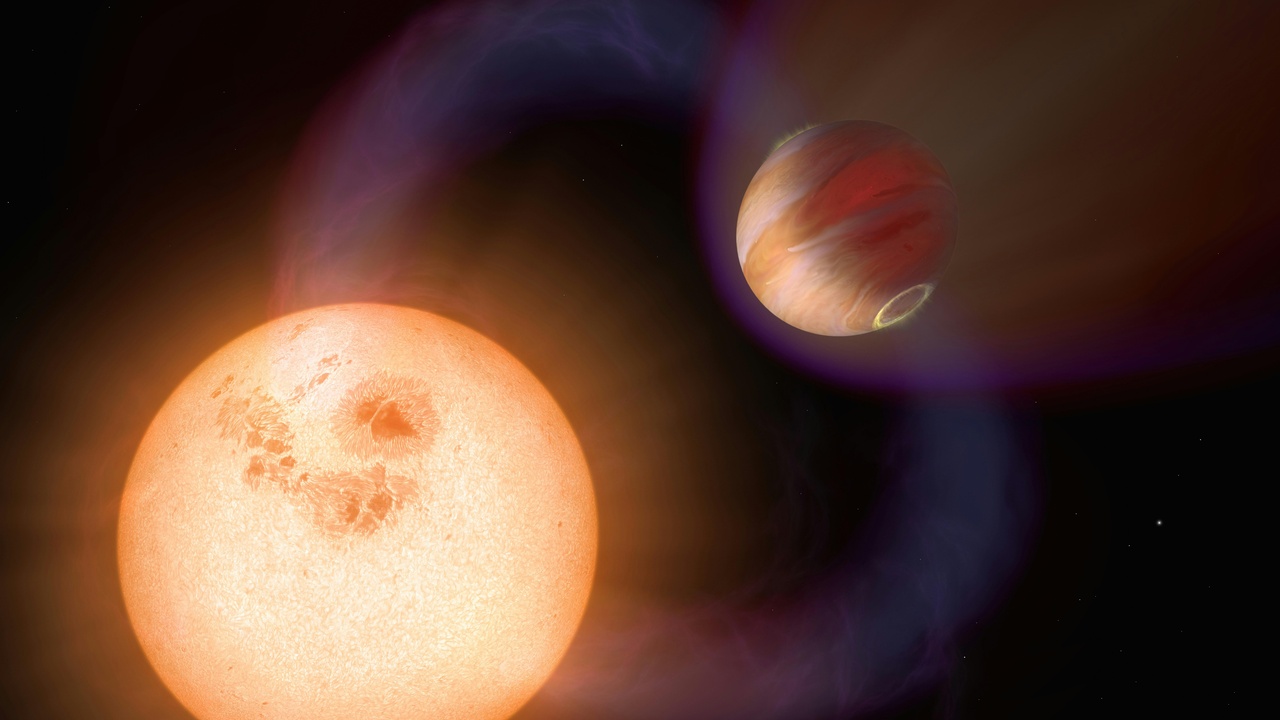
Some atmospheres are messy, transient, or chemically unusual: photochemical hazes, metal-rich exospheres, and actively escaping envelopes fall in this category. These types complicate interpretation because hazes can mask molecular features, and escape sculpts a planet’s long-term evolution. Observations of such systems reveal the intensity of stellar irradiation, magnetic and wind interactions, and the pace at which planets lose mass. Taken together, these classes show how dynamic and diverse planetary atmospheres can be—the very varieties that make atmospheric classification useful for prioritizing follow-up observations.
7. Hazy and photochemical atmospheres
Stellar UV drives photochemistry that produces complex organic aerosols and hazes, which scatter light and commonly mute spectral lines. HD 189733 b shows a blue-scattering haze in optical observations, and the flat transmission spectrum of GJ 1214 b is a classic case where clouds or photochemical hazes complicated composition inferences. Haze formation depends strongly on the host star’s UV output and atmospheric composition, so multiwavelength campaigns—especially longer-wavelength infrared—are needed to penetrate hazes and recover gas signatures. These systems also inform Earth and planetary aerosol models (a useful cross-disciplinary payoff).
8. Escaping, metal-rich and evaporating atmospheres
Intense irradiation can drive hydrodynamic escape, producing extended exospheres or metal-rich vapor envelopes. WASP-12b shows evidence for mass transfer and extreme loss, while the disintegrating candidate KIC 12557548b sports a dusty, comet-like tail. Lava-world candidates such as 55 Cancri e (orbital period 0.74 days) may vaporize rock, creating metal-bearing atmospheres. Mass-loss rates for the most extreme hot Jupiters can reach roughly 10^10–10^12 g/s (order-of-magnitude estimates), though values carry large uncertainties. Observing escaping atmospheres helps connect present-day properties to evolutionary pathways and explains why some close-in planets end up stripped or disintegrated.
Summary
Atmospheric classification condenses diverse observations into actionable categories that link origin, evolution, and habitability; it also guides which targets to prioritize with JWST and future missions.
- Primordial H/He envelopes (e.g., HD 209458 b, WASP-107 b) produce large scale heights and strong spectral signatures that illuminate formation and migration histories.
- Ultra-hot and inflated atmospheres (e.g., KELT-9b, WASP-76b) show atomic metals and extreme chemistry at temperatures >4,000 K, testing high-temperature physics.
- Secondary atmospheres—N2–O2 (TRAPPIST-1e candidates), CO2-dominated (Venus analogue, ~92 bar), and steam-rich (K2-18b signals first reported in 2019)—determine surface conditions and habitability prospects.
- Hazy and escaping atmospheres (HD 189733 b; WASP-12b; disintegrating KIC 12557548b) reveal photochemistry and mass loss that reshape planetary populations; mass-loss rates can reach ~10^10–10^12 g/s in extreme cases.
- With >5,500 confirmed planets as of 2024 and JWST operating since 2021, continued spectroscopy will refine these types, reveal hybrids and surprises, and help answer which worlds might host life—keep watching the new observations.
Enjoyed this article?
Get daily 10-minute PDFs about astronomy to read before bed!
Sign up for our upcoming micro-learning service where you will learn something new about space and beyond every day while winding down.

